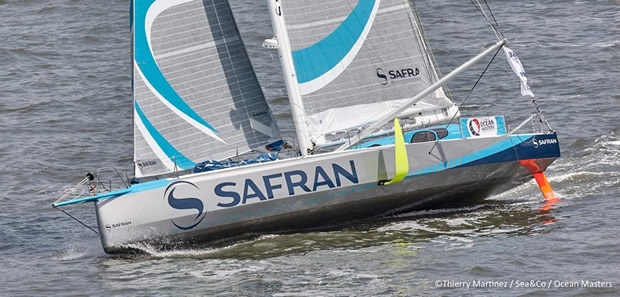
Storms for Thomson as Lagravière contemplates his crash
Alex Thomson continues to extend his lead in the New York – Vendée (Les Sables d’Olonne) Race presented by Currency House and SpaceCode but is currently playing a dicey game as he drives Hugo Boss along into winds that by this evening will be storm force.
Unfortunately for the British skipper, this beating could last longer than he would like as, tantalisingly, the centre of the North Atlantic depression he is sailing towards, is edging east, away from him. Thomson would prefer it remained static, enabling him to sail into the lighter and less punishing winds southeast of the system.
However the Gosport-based skipper can smile slightly at the news that he is putting miles on his competition: Hugo Boss was 85 miles ahead of second placed Jérémie Beyou on Maitre Coq at 1300 UTC today.
As the race leaders are experiencing big conditions, the five tailenders currently 1,100 miles astern are having a more benign time, heading southeast in search of breeze.
From No Way Back, Dutchman Pieter Heerema said his progress wasn’t bad, “except that yesterday most of the day it was extremely light and extremely shifty. The wind was coming from everywhere and nowhere and I didn’t get very far. Since yesterday evening the wind has become a bit more consistent and I have been moving again.” This morning he was seeing an east northeasterly wind that had built to 15 knots, the fog of the last few days now mostly gone. Last night, Heerema said, was stable enabling to catch up on sleep.
A life-long racing sailor, this is Heerema’s first major singlehanded race and he says he is enjoying this aspect of it, although it is a lot harder when things go wrong. “Normal sailing is no problem, but when something happens you have to do everything by yourself. Like yesterday I twice caught some fishermen’s buoys and it was a hassle to get them off - you had to run from the tiller to the back of the boat and down the side, etc.”
Heerema is less looking forward to the upwind sailing that lies ahead as No Way Back has no foil in her port side. She will therefore be underpowered and making leeway whenever she sails on starboard tack. “That definitely will make the boat slower. In light weather it doesn’t matter so much. We’ll just have to see. We are in a group of four or five boats that are all a bit crippled, but it’s the same for all of us. Generally it is all going well. There is just a long way to go. And there’s NO WAY BACK, is there?!”
Skipper Morgan Lagravière, whose yacht Safran was one of the worst affected by the collisions of the early hours of the race, was today still reeling from his accident.
“There is a time when we must take responsibility. When you hit something at 20 knots, you have the impression that the boat will break in two. A ton of water came on board in 15 seconds. It was a critical situation," he recounted. It has taken Lagravière some time to come to terms with returning to the sea singlehanded on his powerful IMOCA 60. “I still have butterflies in my stomach, but that's all part of it. I must finish the race for the team and I will continue to learn doing it.”
Collisions, lessons learned
During the first hours of the race the damage done was not just mechanical. Luckily, no skippers were injured during the number collisions with UFOs on the first day of racing, but the trauma is evident in the statements of skippers since then.
“To work with experts” …a sentiment shared by all the solo skippers, although it was still hard, 48 hours on from the incident, to know exactly the cause of the collisions. Alex Thomson described spotting large schools of sunfish, while PRB skipper Vincent Riou saw sharks and other flotsam. The race committee has started a full investigation with all the teams, as well as marine biologists and coast guards to understand what happened to allow the organisers to establish a plan of action as well as creating more awareness for those involved in professional offshore racing.
The incidents occurred far from the exclusion zone that had been defined in the Sailing Instructions, in response to information provided by marine specialists. The fact that the fleet passed well south of this exclusion zone was possibly not enough.
"We will bring this problem to World Sailing (International Sailing Federation) and work closely with the IMOCA class,” says Peter Bayer, Managing Director of the race’s organisers, Open Sports Management. “We are very saddened that this could happen when we worked to protect marine life which would possibly cross the course of our race. The sailing community is very concerned about protecting nature, especially within the seas, which is our playing field. In our commitment to trying to resolve this issue we will assist other race organisers to find ways to work together with scientists around World Sailing’s Major Oceanic Events commission to improve safety of all races, both current and in the future."
A special IMOCA Ocean Masters edition Delma Shell Star Automatic will be presented to the first three skippers home in the New York - Vendée (Les Sables d'Olonne) as well as the holder of Delma Record, for the boat which has made sailed the most miles over a 24 hour period during the race.
At present the outright singlehanded IMOCA 60 24 hour record is held by François Gabart and MACIF who covered 545.34 miles at an average of 22.72 knots average, during December 2012 which crossing the Indian Ocean en route victory in the Vendée Globe 2012-2013.
Today (Thursday), Hugo Boss' 487 nautical miles passage up until 0500 UTC yesterday, has not been bettered.









Latest Comments
Add a comment - Members log in